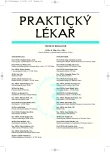Visual cognition and its disorders
Authors:
F. Koukolík
Authors‘ workplace:
Primář: MUDr. František Koukolík, DrSc.
; Národní referenční laboratoř prionových chorob
; Fakultní Thomayerova nemocnice s poliklinikou, Praha
; Oddělení patologie a molekulární medicíny
Published in:
Prakt. Lék. 2008; 88(3): 140-145
Category:
Various Specialization
Overview
The visual system of the brain is functionally specialized. The visual information is processed through two main streams, dorsal and ventral, called the WHERE system and the WHAT system. V1, V2 and V3 are visual cortical maps at the posterior and medial hemispheral surface. Human V4 (hV4) and VO1 (ventral occipital 1) are visual cortical maps at the ventral surface of the occipital lobe. Dorsal visual cortical maps V3A, V3B and V7 are situated forwardly from the posterior part of intraparietal sulcus. Lateral visual cortical maps hMT1 and LOC (lateral occipital complex) are situated from the occipital pole to the superior temporal sulcus. The brain system of colour cognition starts with S, M and L retinal cones. Its hierarchical focal point is called V4. Cerebral achromatopsia is a result of damage to V4. Neurons of the hMT V5 visual cortical area are tuned to motion recognition. Akinetopsia results from damage to this cortical area. There are three cortical areas activated in visual object cognition. Their damage results in visual object agnosia. Face cognition is socially fundamental in humans and other social primates. Its hierarchical focal point is the fusiform face area, FFA. Damage here results in prosopagnosia. Four types of topographical disorientation are due to damage of ego - and/or exocentric representational systems.
Key words:
system WHERE, system WHAT, visual cortical maps, achromatopsia, akinetopsia, visual object agnosia, prosopagnosia, topographical disorientation.
Sources
1. Epstein, R., Kahnwisher, N. A cortical representation of the local visual environment. Nature 1998, 392, p. 598–601.
2. Epstein, R., Higgins, J.S. Differential parahippocampal and retrosplenial involvement in three types visual scene recognition. Cereb. Cortex 2007; 17: p. 1680-1693.
3. Epstein, R., Parker, W.E., Feiler, A.M.. Where Am I now? Distinct roles for parahippocampal and retrosplenial cortices in place recognition. European Journal Neuroscience 2007, 25, p. 890-899.
4. Gegenfurter, K. R. Cortical mechanisms of colour vision. Nature Reviews Neuroscience 2003, 4, p. 563-572.
5. Graman, K., Müller, H.J., Schönebeck, B. et al. The neural basis of ego-and allocentric reference frames in spatial navigation: evidence from spatio-temporal coupled current density reconstruction. Brain Res. 2006, 1118 (1), p. 116-129.
6. Grill-Spector, K., Malach, R. The human visual cortex. Annu Rev. Neurosci 2004, 27, p. 649–677.
7. Hasson, U., Harel, M., Levy, I. et al. Large-scale mirror-symmetry organization of human occipito-temporal object areas. Neuron 2003, 37, p. 1027–1041.
8. Haxby, J.V., Gobbini, M.I, Furey, M.L. et al. Distributed and overlapping representations of faces and objects in ventral temporal cortex. Science, 2001, 293, p. 2425–2430.
9. Chandrasekhar, Ch., Canon, V., Dahmen, J.C. et al. Neural correlated of disparity-defined shape discrimination in the human brain. J. Neurophysiol. 2007, 97, p. 1553-1565.
10. Kanwisher, N. Domain specificity in face perception. Nat. Neurosci. 2000, 3, p. 759-763.
11. Merriam, E-P., Genovese, Ch.R., Colby C.L. Remapping in human visual cortex. J. Neurophysiol. 2007, 97, p. 1738-1755.
12. Rossion, B., Caldara, R., Seghier, M. et al. A network of occipito-temporal face-sensitive areas besides the right middle fusiform fusiform gyrus is necessary for normal face processing. Brain, 2003, 126, p. 2381-2396.
13. Sack A.T., Kohler, A., Linden, D.E.J. et al. The temporal characteristics of motion processing in hMT/V5+: combining fMR and neuronavigated TMS. NeuroImage 2006, 29, p. 1326-1335.
14. Sorger, B., Goebbel, R., Schiltz, C. et al. Understanding the functional neuroanatomy of acquired prosopagnosia. NeuroImage 2007, 35, p. 836-852.
15. Summerfield, Ch., Egner, T., Mangels, J. et al. Mistaking a house for face: neural correlates of misperception in healthy humans. Cerebral Cortex 2006, 16, p. 500-508.
16. Wandell, B.A., Brewer, A.A., Dougherty, R.F. Visual field map clusters in human cortex. Phil. Trans. R. Soc. B 2005, 360, p. 693-707.
Labels
General practitioner for children and adolescents General practitioner for adultsArticle was published in
General Practitioner

2008 Issue 3
- Hope Awakens with Early Diagnosis of Parkinson's Disease Based on Skin Odor
- Metamizole at a Glance and in Practice – Effective Non-Opioid Analgesic for All Ages
- Memantine in Dementia Therapy – Current Findings and Possible Future Applications
- Metamizole vs. Tramadol in Postoperative Analgesia
- Memantine Eases Daily Life for Patients and Caregivers
Most read in this issue
- Genitourinary tuberculosis – current state
- The convergence between neurological and psychogenic etiopathogenesis and the possibilities of psychotherapy.
- The importance of oral hygiene in the prevention of plaque induced oral cavity diseases
- Combined chelation treatment in patients with myelodysplastic syndrome and hereditary hemochromatosis – a case study
